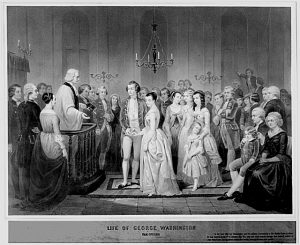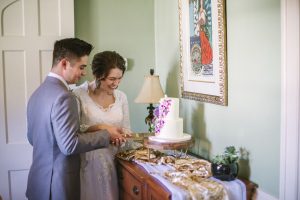July 1, 2021
Colonial Wedding Customs
As America’s 245th birthday draws near, I’ve had colonial times on the brain. With my recent discovery that Queen Victoria provided us the tradition of the white wedding dress in 1840, I wondered which traditions colonial brides gave us (if any). My recent trip to Colonial Williamsburg didn’t help take my mind off the matter, so I decided to look into it.

An imagining of the “Wedding of George Washington and Martha Custis.” Lithograph from Prints and Photographs Division, Library of Congress. Paris: Lemercier, c1853.
First things first, the dress.
Since I already told you that the white wedding gown tradition didn’t begin until Queen Victoria married Prince Albert in 1840, I’m sure you won’t be surprised to learn that colonial brides didn’t traditionally wear white. They wore their best dress (in a variety of colors). What may surprise you, is that, unlike modern brides who likely only wear their wedding dress on their wedding day, colonial brides were outfit repeaters. Because of the cost of fine fabrics, these brides would wear their wedding dresses again after their big day for other fancy events.


Engagement.
Believe it or not, what we consider an engagement (then called a spousal de futuro) was a rather rare occasion in colonial America. Many marriages included traditional English customs (dowery, betrothal, traditional ceremony). However, often a couple would just obtain a marriage license (costing about 50 pounds) or have banns published in their church.
What are banns you ask? Well, they are a notice of the couple’s intention to marry (which had to be published in church for three meetings in a row) which allowed any member of the church or community to object to the marriage. If no objections arose, the couple was then provided with a certificate of marriage. Banns were much cheaper than a marriage license (but obviously took longer).
In case you’re wondering, you had to be 21 and free to legally marry without the written consent of a parent.

Church Weddings.
It was very common for any wedding ceremony to take place in a church (especially since the banns had to be published in a church). However, even when the couple chose to get married in their own home (often due to living so far from the church itself), a Church of England minister still had to officiate the ceremony for it to be legal.

Liturgy.
Many of the words that we now know as traditional wedding vows originate from the Book of Common Prayer (used to officiate any church ceremony – including a wedding). One 1750 edition of the BCP included this liturgy that may seem a little bit familiar to you today.
“Dearly beloved, we are gathered together here in the sight of God, and in the face of this Congregation, to join together this Man and this Woman in holy Matrimony…”
“Wilt thou have this Man to thy wedded Husband, to live together after God’s Ordinance, in the holy Estate of Matrimony? Wilt thou obey him, serve him, love, honour and keep him in sickness and in health, and forsaking all other, keep thee only unto him, so long as ye both shall live?”
“With this Ring, I thee wed, with my body I thee worship, and with all my worldly goods I thee endow…”

Wedding Season.
Unlike modern wedding season (spring – fall) many colonial weddings took place during the colder months of the year (December through early February). Of course, there was so much to do agriculturally during the colonial times that these colder months afforded more time for parties (like weddings).

The Party!!!
Colonial wedding parties could go on for days at a time. The food was plentiful, the drinks were flowing, and of course, there were games and dancing. For colonial Virginia, you could expect to see fish and oysters along with crops like potatoes and pumpkin casserole at a wedding party.
There were also two cakes, one for the bride and one for the groom (a tradition often continued today). The groom’s cake was usually white and was the one consumed by the guests at the wedding while the bride’s cake (the closest thing to compare it to is today’s version of a fruitcake) was sometimes left for the happy couple to eat together on an anniversary. When it was shared, it included a piece of nutmeg hidden somewhere within the cake. Whichever guest received the piece of cake containing the nutmeg would be the next to marry (sort of like today’s tossing of the bouquet tradition).

In the last 245 years, weddings have changed quite a bit. But the heart of the celebration remains the same.
Photos from Clara & Austin’s colonial-inspired elopement.

